Key (lock)
It has been suggested that this article be merged into Lock (security device). (Discuss) Proposed since October 2018. |
This article has multiple issues. Please help improve it or discuss these issues on the talk page. (Learn how and when to remove these messages)
|
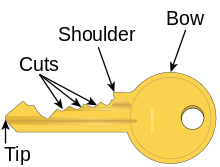
A key is a device that is used to operate a lock (such as to lock or unlock it). A typical key is a small piece of metal consisting of two parts: the bit or blade, which slides into the keyway of the lock and distinguishes between different keys, and the bow, which is left protruding so that torque can be applied by the user. A key is usually intended to operate one specific lock or a small number of locks that are keyed alike, so each lock requires a unique key. The key serves as a security token for access to the locked area; only persons having the correct key can open the lock and gain access. Common metals include brass, plated brass, nickel silver, and steel.
Keys provide an inexpensive, though imperfect, method of access control for access to physical properties like buildings, vehicles and cupboards or cabinets. As such, keys are an essential feature of modern living, and are common around the world. It is common for people to carry the set of keys they need for their daily activities around with them, often linked by a keyring, which may be adorned by trinkets, usually known as a keychain.
History
The Ancient Near East and Mediterranean



The earliest known lock was found in 1842 in the ruins of Emperor Sargon II’s palace in what was then the capital city of 8th-century B.C. Assyria, Dur-Sharrukin (now present-day Khorsabad in Iraq).[1] Locks such as this were later developed into the Egyptian wooden pin lock, which consisted of a bolt, door fixture, and key. When the key was inserted, pins in the fixture were lifted out drilled holes in the bolt, allowing it to move. When the key was removed, the pins fell part-way into the bolt, preventing movement.[2]
The warded lock was also present from antiquity and remains the most recognizable lock and key design in the Western world. The first all-metal locks appeared between the years 870 and 900, and are attributed to the English craftsmen.[3] It is also said that the key was invented by Theodore of Samos in the 6th century BC.[4]
Affluent Romans often kept their valuables in secure boxes in their households, and wore the keys as rings on their fingers. The practice had two benefits: It kept the key handy at all times, while signaling that the wearer was wealthy and important enough to have money and jewelry worth securing.[5]
Modern Europe and America


With the onset of the Industrial Revolution in the late 18th century and the concomitant development of precision engineering and component standardisation, locks and keys were manufactured with increasing complexity and sophistication.
The lever tumbler lock, which uses a set of levers to prevent the bolt from moving in the lock, was perfected by Robert Barron in 1778.[6] His double acting lever lock required the lever to be lifted to a certain height by having a slot cut in the lever, so lifting the lever too far was as bad as not lifting the lever far enough. This type of lock is still currently used today.[7]
The lever tumbler lock was greatly improved by Jeremiah Chubb in 1818. A burglary in Portsmouth Dockyard prompted the British Government to announce a competition to produce a lock that could be opened only with its own key.[8] Chubb developed the Chubb detector lock, which incorporated an integral security feature that could frustrate unauthorised access attempts and would indicate to the lock's owner if it had been interfered with. Chubb was awarded £100 after a trained lock-picker failed to break the lock after 3 months.[9]
In 1820, Jeremiah joined his brother Charles in starting their own lock company, Chubb. Chubb made various improvements to his lock; – his 1824 improved design didn't require a special regulator key to reset the lock, by 1847 his keys used six-levers rather than four and he later introduced a disc that allowed the key to pass but narrowed the field of view, hiding the levers from anybody attempting to pick the lock.[10] The Chubb brothers also received a patent for the first burglar-resisting safe and began production in 1835.
The designs of Barron and Chubb were based on the use of movable levers, but Joseph Bramah, a prolific inventor, innovated an alternative method in 1784. His lock used a cylindrical key with precise notches along the surface; these moved the metal slides that restricted the turning of the bolt into an exact alignment, allowing the lock to open. The lock lay at the cutting edge of the precision machine tooling capabilities of the time and was deemed by its inventor as unbreakable. In the same year Bramah started the Bramah Locks company at 124 Piccadilly, and displayed the "Challenge Lock" in the window of his shop from 1790, challenging "...the artist who can make an instrument that will pick or open this lock" for the reward of £200. The challenge stood for over 67 years until, at the Great Exhibition of 1851, the American locksmith Alfred Charles Hobbs was able to open the lock and, following some argument about the circumstances under which he had opened it, was awarded the prize. Hobbs' attempt required some 51 hours, spread over 16 days.
The earliest patent for a double-acting pin tumbler lock was granted to American physician Abraham O. Stansbury in England in 1805,[11] but the modern version, still in use today, was invented by American Linus Yale, Sr. in 1848.[12] This lock design used pins of varying lengths to prevent the lock from opening without the correct key. In 1861, Linus Yale, Jr. was inspired by the original 1840s pin-tumbler lock designed by his father, thus inventing and patenting a smaller flat key with serrated edges as well as pins of varying lengths in the lock itself, the same design of the pin-tumbler lock which still remains in use today.[13] The modern pin tumbler lock key is essentially a more developed version of the Egyptian lock.
Despite some improvement in key design since, the majority of locks today are still variants of the designs invented by Bramah, Chubb and Yale.
Types
Common
Pin tumbler
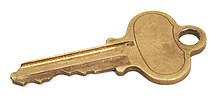
A pin tumbler lock key is commonly found on homes. When held upright, as if to open a door, a series of grooves on either side of the key (the key's blade) limits the type of lock the key can slide into. As the key slides into the lock, the grooves on the blade of the key align with the wards in the keyway allowing or denying entry to the cylinder. Then a series of pointed teeth and notches on the blade called bittings allow pins or wafers to move up and down until they align with the shear line of the inner and outer cylinder, allowing the cylinder or cam to rotate freely inside the lock, which opens the lock.[14]
Lever
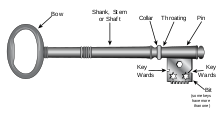
A lever lock is made up of a set of 'levers' (typically between two and eight) which are raised to different heights by the key when it is turned. Once all the levers have been moved to the correct height, the locking bolt is free to slide across and secure the door. The teeth or bittings of the key have flat tops rather than being pointed. Lever lock keys tend to be bigger and less convenient for carrying, although lever locks are considered to be harder to pick and so are recommended by most insurance companies.[15]
Lever locks are more commonly found in Argentina, the United Kingdom, and parts of Scandinavia.
Tubular
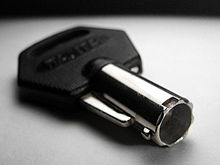
A tubular key (sometimes referred to as an ace, radial or barrel key) is one that is designed to open a tubular pin tumbler lock. It has a hollow, cylindrical shaft that is usually much shorter and has a larger diameter than most conventional keys. Tubular keys are commonly found on vending machines, launderettes, bike locks, and laptop security cables.
The modern version of this type of key is harder to duplicate as it is less common and requires a different machine from regular keys. These keys typically come in four and eight-pin models. Tubular keys were invented in 1934 by the Chicago Lock company in Chicago, IL under the ACE brand.[16]
Maison
A Maison key system is a keying system that permits a lock to be opened with a number of unique, individual keys.[17] Maison key systems are often found in apartment building common areas, such as main entrance or a laundry room where individual residents can use their own apartment key to access these areas. Unlike a master key system, where each individual lock has one individual operating key and one common master key, Maison lock is designed to be operated by every key within the system.
Because of the inherent lack of security in the Maison key system, some jurisdictions prohibit the use of Maison key systems in apartment and condominium complexes. In such locations, access is usually facilitated by either a high-security, key-controlled system or the use of electronic access control systems such as a card reader.
Car
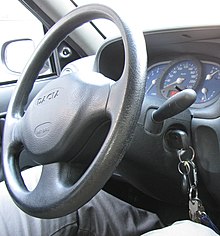
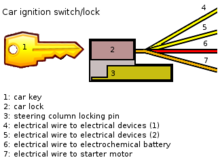
A car key or an automobile key is a key used to open and/or start an automobile. Modern key designs are usually symmetrical, and some use grooves on both sides, rather than a cut edge, to actuate the lock. It has multiple uses for the automobile with which it was sold. A car key can open the doors, as well as start the ignition, open the glove compartment and also open the trunk (boot) of the car. Some cars come with an additional key known as a valet key that starts the ignition and opens the driver's side door, but prevents the valet from gaining access to valuables that are located in the trunk or the glove box. Some valet keys, particularly those to high-performance vehicles, go so far as to restrict the engine's power output to prevent joyriding.[18] Recently, features such as coded immobilizers have been implemented in newer vehicles. More sophisticated systems make ignition dependent on electronic devices, rather than the mechanical keyswitch. A number of these systems, such as KeeLoq and Megamos Crypto have been demonstrated to be weak and vulnerable to cryptanalytic attacks.[19]
Ignition switches or locks are combined with security locking of the steering column (in many modern vehicles) or the gear lever (such as in Saab Automobile vehicles). In the latter, the switch is between the seats, preventing damage to the driver's knee in the event of a collision.
Keyless entry systems, which use either a door-mounted keypad or a remote control in place of a car key, have become a standard feature on most new cars. Some of them are handsfree.
Some high-tech automotive keys are billed as theft deterrents. Mercedes-Benz uses a key that, rather than have a cut metal piece to start the car, uses an encoded infrared beam that communicates with the car's computer. If the codes match, the car can be started. These keys can be expensive to replace if lost and can cost up to US $400.
A switchblade key is basically the same as any other car key, except in appearance. The switchblade key is designed to fold away inside the fob when it is not being used. Switchblade keys have become very popular recently because of their smart compact look. These type of keys are also commonly referred as Flip Keys. Because switchblade keys are only developed for new car models, they are usually equipped with a programmed transponder chip.
History
Automobiles had door keys earlier, but the first ignition keys that also operated the starter mechanism were introduced by Chrysler in 1949. Popular Mechanics, in April 1949, wrote:
Among the innovations of primary interest to the driver is the combination ignition and starter switch which eliminates the starter button. The car starts by turning the ignition key slightly beyond the 'ignition on' position. When released, the key automatically returns to 'ignition on'. Aside from the convenience to the driver, this starter makes it impossible for children to move a car which has been left in gear by pushing the starter button.[20]
In the 1950s, early versions of "flip keys" resembling jack knives were made by the Signa-Craft company out of New York with various period U.S. automaker's prototype "Dream Cars" like the Pontiac Strato-Streak and the Cadillac El Camino featured on them. These are now popular with collectors.
Signa-Craft and other manufacturers like Curtis, Taylor Locks, and Mr. Key also produced keys for many 1950's-1970's makes and models known as "Crest Keys". These were automotive keys that featured an enameled rendition of the auto manufacturer's logo on the bow and were plated in 14k gold. During the early 1960s, these special keys became so popular that oil companies like Mobil, Texaco, and Union 76 began issuing their own logoed versions as promotional items for their customers. Today, these early automotive crest keys are highly sought after by collectors.
Meanwhile, companies like Hurd and Briggs and Stratton were making OEM key blanks with automaker's logos on them. These became known as "Logo Blanks". These key blanks were the same as the original keys issued by the automaker and allowed an enthusiast to maintain the stock look of his or her keys. Picky car show judges will often score a vehicle down for not having a correct OEM set of keys with the original lock code stamped on them. Unfortunately, many of these original logo blanks are no longer manufactured and are only available from dwindling NOS supplies from internet places such as eBay.[21]
Internal cut
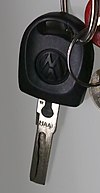
An internal cut (also known as "sidewinder" or "laser cut") key has a rectangular blade with a wavy groove cut up the center of the face of the blade, at a constant depth.
Typically the key has an identical wavy groove on the back of the blade, making it symmetrical so it works no matter which way it is inserted. These keys must be cut by special key cutting machines made for them.[22]
Transponder
Transponder keys may also be called "chip keys". Transponder keys are automotive ignition keys with signal-emitting circuits built inside.
When the key is turned in the ignition cylinder, the car's computer transmits a radio signal to the transponder circuit. The circuit has no battery; it is energized by the radio signal itself. The circuit typically has a computer chip that is programmed to respond by sending a coded signal back to the car's computer. If the circuit does not respond or if the code is incorrect, the engine will not start. Many cars immobilize if the wrong key is used by intruders. Chip Keys successfully protect cars from theft in two ways: forcing the ignition cylinder won't start the car, and the keys are difficult to duplicate. This is why chip keys are popular in modern cars and help decrease car theft.
Many people who have transponder keys, such as those that are part of Ford Motor Company's SecuriLock system, are not aware of the fact because the circuit is hidden inside the plastic head of the key. On the other hand, General Motors produced what are known as VATS keys (Vehicle Anti-Theft System) during the 1990s, which are often erroneously believed to be transponders but actually use a simple resistor, which is visible in the blade of the key. If the electrical resistance of the resistor is wrong, or the key is a normal key without a resistor, the circuit of the car's electrical system will not allow the engine to get started.
Others
Double-sided
A double-sided key is very similar to a house or car key with the exception that it has two sets of teeth, an upper level standard set of teeth and a lower, less defined set of teeth beside it. This makes the double-sided key's profile and its corresponding lock look very similar to a standard key while making the attempt to pick the lock more difficult.
Paracentric
A paracentric key is designed to open a paracentric lock. It is distinguishable by the contorted shape of its blade, which protrudes past the centre vertical line of the key barrel. Instead of the wards on the outer face of the lock simply protruding into the shape of the key along the spine, the wards protrude into the shape of the key along the entire width of the key, including along the length of the teeth.[23]
Another way to describe a paracentric key is that the cylinders are not in a straight line, but can vary to the right or left, so that the key not only has to have the correct height of the pin for a cylinder, the pin is also extended to the left or right of the center of the key.

Abloy
Abloy keys are cut from a metal half-cylinder. The cuts are made at different angles, so when the key is turned in the lock it rotates each disk a different amount.
Nearly all the houses in Finland use Abloy keys, although they are also widely used in various locales worldwide. These locks are considered very secure and almost impossible to pick.[24][25][26]
Dimple
A dimple key has a rectangular blade with various cone-shaped dimples drilled into the face of the blade at various depths. Typically the lock has 2 rows of pins that match up with 2 rows of dimples. Typically the key has the same dimple pattern on the back of the blade, making it symmetrical so it works no matter which way it is inserted.[27][28]
Kaba and Dom are manufactures of dimpled keys. These keys are relatively easy to not only pick, but also make impressions of.[29]
Skeleton
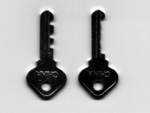
A "skeleton key" (also known as a "passkey") is a type of master key in which the serrated edge has been filed down so that it can open numerous locks.[30] The term derives from the fact that the key has been reduced to its essential parts.[30] In a broader sense the term can be used synonymously with master key to refer to any key, keycard or other device capable of opening a variety of locks.
In US English usage, "skeleton key" is also used to mean a standard lever lock key.
Cruciform key
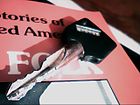
A Cruciform key has three sets of teeth at 90 degrees to each other with a flattened fourth side. Though this type of key is easy to duplicate, the extra sets of teeth deter lockpicking attempts.
Magnetic

A magnetic keyed lock is a locking mechanism whereby the key utilizes magnets as part of the locking and unlocking mechanism.
A magnetic key would use from one to many small magnets oriented so that the North and South poles would equate to a combination to push or pull the lock's internal tumblers thus releasing the lock. This is a totally passive system requiring no electricity or electronics to activate or deactivate the mechanism. Using several magnets at differing polarity / orientations and different strengths can allow thousands of different combinations per key.[32]
Digital
Keycard
A keycard is a flat, rectangular plastic card with identical dimensions to that of a credit card or driver's license that stores a physical or digital signature that the door mechanism accepts before disengaging the lock.
There are several popular type of keycards in use including the mechanical holecard, bar code, magnetic stripe, Wiegand wire embedded cards, smart card (embedded with a read/write electronic microchip), and RFID proximity cards.
Keycards are frequently used in hotels as an alternative to mechanical keys. New smart lock technologies are gradually integrating and bringing keycard technology to smartphones.[33]
Smart
A smart key is an electronic access and authorization system which is commonly available as an option or standard in several cars. However, with the hastened development of mobile and smart technologies, house and office keys are increasingly integrated into smartphones, where they act as virtual keys and access rights for users.[34][35]
Systems
Individually keyed system (KD)
With an individually keyed system, each cylinder can be opened by its unique key.
Keyed alike (KA)
This system allows for a number of cylinders to be operated by the same key. It is ideally suited to residential and commercial applications such as front and back doors.
Common entrance suite / Maison keying (CES)
This system is widely used in apartments, office blocks and hotels. Each apartment (for example) has its own individual key which will not open the doors to any other apartments, but will open common entrance doors and communal service areas. It is often combined with a master-keyed system in which the key is kept by the landlord.
Master keyed (MK)

A master key operates a set of several locks. Usually, there is nothing special about the key itself, but rather the locks into which it will fit. These master-keyed locks are configured to operate with two, or more, different keys: one specific to each lock (the change key), which cannot operate any of the others in the set, and the master key, which operates all the locks in the set. Locks that have master keys have a second set of the mechanism used to operate them that is identical to all of the others in the set of locks. For example, master keyed pin tumbler locks often have two shear points at each pin position, one for the change key and one for the master key. A far more secure (and more expensive) system has two cylinders in each lock, one for the change key and one for the master key.
A common misconception is that master keyed locks are more secure than single keyed locks, but that is not the case. The fact that some pin chambers have two shear points allows for more options when picking and it also allows for more keys to operate. For example, a standard 6 pin cylinder, which was designed to be operated by only one key, can be operated by up to 2^6=64 keys if there are two shear points in each chamber.
Larger organizations, with more complex systems, may have several levels of master keys, where the top level key works in all of the locks in the system. To visualize this, it can be thought of as a hierarchical chart, or a tree.
A practical attack exists to create a working master key for an entire system given only access to a single master-keyed lock, its associated change key, a supply of appropriate key blanks, and the ability to cut new keys. This is described in a 2002 paper by cryptographer Matt Blaze,[36] however for systems with many levels of master keys it may be necessary to collect information from locks in different "subsystems" in order to deduce the master key.
Locksmiths may also determine cuts for a replacement master key, when given several different key examples from a given system.
Control key
A control key is a special key used in removable core locking systems. The control key enables a user, who has very little skill, to remove from the core, with a specific combination, and replace it with a core that has a different combination. In Small Format Interchangeable Cores locks (SFIC), similar to those developed by Frank Best of the Best Lock Corporation, the key operates a separate shear line that is located above the operating key shear line. In Large Format Removable Cores (LFRC), the key may operate a separate shear line or the key may work like a master key along the operating shear line and also contact a separate locking pin that holds the core in the cylinder. SFIC's are transferable from one brand's housing to another, while LFRC's are not.
Duplication
Key cutting (after cutting, the metalworking term for "shaping by removing material") is the primary method of key duplication: a flat key is fitted into a vise in a machine, with a blank attached to a parallel vise, and the original key is moved along a guide, while the blank is moved against a wheel, which cuts it. After cutting, the new key is deburred: scrubbed with a metal brush to remove burrs, small pieces of metal remaining on the key, which, were they not removed, would be dangerously sharp and, further, foul locks.
Different key cutting machines are more or less automated, using different milling or grinding equipment, and follow the design of early 20th century key duplicators.
Key duplication is available in many retail hardware stores and as a service of the specialized locksmith, though the correct key blank may not be available. More recently, online services for duplicating keys have become available.
Do not duplicate key
A "do not duplicate" key (or DND key, for short) is one that has been stamped "do not duplicate", "duplication prohibited" or similar by a locksmith or manufacturer as a passive deterrent to discourage a retail key cutting service from duplicating a key without authorization or without contacting the locksmith or manufacturer who originally cut the key. More importantly, this is a key control system for the owner of the key, such as a maintenance person or security guard, to identify keys that should not be freely distributed or used without authorization. Though it is intended to prevent unauthorized key duplication, copying DND keys remains a common security problem.
Restricted key
A restricted keyblank has a keyway for which a manufacturer has set up a restricted level of sales and distribution. Restricted keys are often protected by patent, which prohibits other manufacturers from making unauthorized productions of the key blank. In many cases, customers must provide proof of ID before a locksmith will cut additional keys using restricted blanks. Some companies, such as Medeco High Security Locks, have keyways that are restricted to having keys cut in the factory only. This is done to ensure the highest amount of security. These days, many restricted keys have special in-laid features, such as magnets, different types of metal, or even small computer chips to prevent duplication.
Another way to restrict keys is trademarking the profile of the key. For example, the profile of the key can read the name of the manufacturer. The advantage of a trademark is that the legal protection for a trademark can be longer than the legal protection for a patent. However, usually not all features of the profile are necessary to create a working key. By removing certain unnecessary features, a non restricted profile can be derived, allowing the production and distribution of non restricted key blanks.
Heraldry
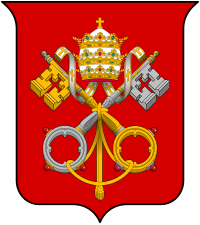

Keys appear in various symbols and coats of arms, the best-known being that of the Holy See – derived from the phrase in Matthew 16:19 which promises Saint Peter, in Roman Catholic tradition the first pope, the Keys of Heaven. But this is by no means the only case. Many examples are given on Commons.
Palestinian symbol
Among Palestinians, the key is widely used as a symbol of commemoration of the Nakba (the 1948 Palestine war in which Israel was created and hundreds of thousands of Palestinians became refugees). This usage is derived from the fact that many of the Palestinians who became refugees in 1948 had locked their homes when leaving, expecting to return soon, and took the keys with them. Such keys are preserved as family heirlooms in many Palestinian refugee families - even though the house to which the keys belong often does not exist anymore. In Palestinian posters and in signs carried in demonstrations, a key is used to denote the demand for the Palestinian Right of Return.
See also
References
- ^ Bill Philips, The Complete Book of Locks and Locksmithing, McGraw Hill Professional 2005, p.1.
- ^ Ceccarelli, Marco (2004). International Symposium on History of Machines and Mechanisms. New York: Kluwer Academic Publishers. p. 43. ISBN 1402022034. Archived from the original on 26 April 2016.
{{cite book}}: Unknown parameter|deadurl=ignored (|url-status=suggested) (help) - ^ "History". Locks.ru. Archived from the original on 20 April 2010. Retrieved 10 June 2010.
{{cite web}}: Unknown parameter|deadurl=ignored (|url-status=suggested) (help) - ^ "History". Dimensions Info. Archived from the original on 18 January 2013. Retrieved 9 December 2012.
{{cite web}}: Unknown parameter|deadurl=ignored (|url-status=suggested) (help) - ^ "History". Slate Magazine. Archived from the original on 9 December 2012. Retrieved 9 December 2012.
{{cite web}}: Unknown parameter|deadurl=ignored (|url-status=suggested) (help) - ^ "Barron". www.historyoflocks.com. Archived from the original on 22 March 2015. Retrieved 22 March 2016.
{{cite web}}: Unknown parameter|deadurl=ignored (|url-status=suggested) (help) - ^ Pulford, Graham W. (2007). High-Security Mechanical Locks: An Encyclopedic Reference. Elsevier. p. 317. ISBN 0-7506-8437-2.
- ^ "History of Locks". Encyclopaedia of Locks and Builders Hardware. Chubb Locks. 1958. Archived from the original on 23 September 2006. Retrieved 16 November 2006.
{{cite web}}: Unknown parameter|deadurl=ignored (|url-status=suggested) (help) - ^ "Lock Making: Chubb & Son's Lock & Safe Co Ltd". Wolverhampton City Council. 2005. Retrieved 16 November 2006.
- ^ Roper, C.A.; Phillips, Bill (2001). The Complete Book of Locks and Locksmithing. McGraw-Hill Publishing. ISBN 0-07-137494-9.
- ^ The Complete Book of Home, Site, and Office Security: Selecting, Installing, and Troubleshooting Systems and Devices. McGraw-Hill Professional. p. 11. Archived from the original on 21 November 2016.
{{cite book}}: Unknown parameter|deadurl=ignored (|url-status=suggested) (help) - ^ The Geek Atlas: 128 Places Where Science and Technology Come Alive. O'Reilly Media, Inc. p. 445. Archived from the original on 1 May 2016.
{{cite book}}: Unknown parameter|deadurl=ignored (|url-status=suggested) (help) - ^ "Inventor of the Week Archive". Massachusetts Institute of Technology. Archived from the original on 29 May 2013.
{{cite web}}: Unknown parameter|deadurl=ignored (|url-status=suggested) (help) - ^ Make your ideas part of the revolution (4 November 2011). "Popular Science, November 1946 ''How Your Home Lock Works''". Popsci.com. Archived from the original on 20 September 2012. Retrieved 8 November 2011.
{{cite web}}: Unknown parameter|deadurl=ignored (|url-status=suggested) (help) - ^ "Insurance company requirements | The Crime Prevention Website". thecrimepreventionwebsite.com. Archived from the original on 14 March 2016. Retrieved 18 March 2016.
{{cite web}}: Unknown parameter|deadurl=ignored (|url-status=suggested) (help) - ^ "Chicago Lock Co., v. Morris V. Fanberg and Victor Fanberg" (PDF). Archived from the original (PDF) on 4 March 2016. Retrieved 22 May 2015.
{{cite web}}: Unknown parameter|deadurl=ignored (|url-status=suggested) (help) - ^ "The Maison Key System and Its Uses". www.altonalocksmiths.com.au. Archived from the original on 2 February 2017. Retrieved 28 January 2017.
{{cite web}}: Unknown parameter|deadurl=ignored (|url-status=suggested) (help) - ^ Gary Labb. "Prevention". Orange County Auto Theft Task Force. Archived from the original on 15 August 2010. Retrieved 10 June 2010.
{{cite web}}: Unknown parameter|deadurl=ignored (|url-status=suggested) (help) - ^ "Dismantling Megamos Crypto: Wirelessly Lockpicking a Vehicle Immobilizer" (PDF). USENIX. 2015. Archived from the original (PDF) on 21 August 2015.
{{cite web}}: Unknown parameter|deadurl=ignored (|url-status=suggested) (help) - ^ Popular Mechanics Apr 1949
- ^ Antique Classic Marque Car Keys 2nd Edition by Don Stewart, 1993
- ^ Framon Sidewinder Instruction Manual Archived 9 August 2014 at the Wayback Machine Retrieved 8 August 2014.
- ^ "Notes on Picking Pin Tumbler Locks". Crypto.com. Archived from the original on 22 March 2010. Retrieved 10 June 2010.
{{cite web}}: Unknown parameter|deadurl=ignored (|url-status=suggested) (help) - ^ "Abloy". Yarchive.net. Archived from the original on 23 May 2013. Retrieved 23 October 2013.
{{cite web}}: Unknown parameter|deadurl=ignored (|url-status=suggested) (help) - ^ "Abloy Locks". Data-security-safe.com. Archived from the original on 20 September 2010. Retrieved 10 June 2010.
{{cite web}}: Unknown parameter|deadurl=ignored (|url-status=suggested) (help) - ^ "Showing the angles on an Abloy key". Archived from the original on 24 July 2011. Retrieved 10 June 2010.
{{cite web}}: Unknown parameter|deadurl=ignored (|url-status=suggested) (help) - ^ "dimple key « Blackbag, Barry's weblog". Blackbag.nl. Archived from the original on 17 August 2013. Retrieved 23 October 2013.
{{cite web}}: Unknown parameter|deadurl=ignored (|url-status=suggested) (help) - ^ "DOM ix Dimple key system" (PDF). Archived from the original (PDF) on 6 June 2013. Retrieved 20 May 2015.
{{cite web}}: Unknown parameter|deadurl=ignored (|url-status=suggested) (help) - ^ "Advanced foil impressioning « Blackbag, Barry's weblog". Blackbag.nl. 1 February 2010. Archived from the original on 10 October 2011. Retrieved 8 November 2011.
{{cite web}}: Unknown parameter|deadurl=ignored (|url-status=suggested) (help) - ^ a b Collins English Dictionary (10th ed.). Glasgow: Collins. 2009. ISBN 978-0-00-729846-4.
- ^ "Avocet ABS - high security diamond grade locks". www.abs-secure.co.uk. Archived from the original on 8 March 2016. Retrieved 8 March 2016.
{{cite web}}: Unknown parameter|deadurl=ignored (|url-status=suggested) (help) - ^ "Magnetic Locks" (PDF). Chubb Locks Custodial Services Ltd. Archived from the original (PDF) on 30 August 2007. Retrieved 29 October 2007.
- ^ Widness, Brett. "Bringing Keycard Technology To Smartphones". Urban Land Institute. Archived from the original on 2 June 2015. Retrieved 9 June 2015.
{{cite web}}: Unknown parameter|deadurl=ignored (|url-status=suggested) (help) - ^ Kurutz, Steven. "Losing the Key". The New York Times. The New York Times. Archived from the original on 31 May 2015. Retrieved 18 May 2015.
{{cite web}}: Unknown parameter|deadurl=ignored (|url-status=suggested) (help) - ^ Perez, Sarah. "Smart Keyless Access System KISI Lets You Swipe To Open Your Door". Techcrunch. Techcrunch. Archived from the original on 20 May 2015. Retrieved 19 May 2015.
{{cite web}}: Unknown parameter|deadurl=ignored (|url-status=suggested) (help) - ^ "Cryptology and Physical Security: Rights Amplification in Master-Keyed Mechanical Locks" (PDF). Crypto.com. Archived from the original (PDF) on 2 October 2013. Retrieved 23 October 2013.
{{cite web}}: Unknown parameter|deadurl=ignored (|url-status=suggested) (help)
